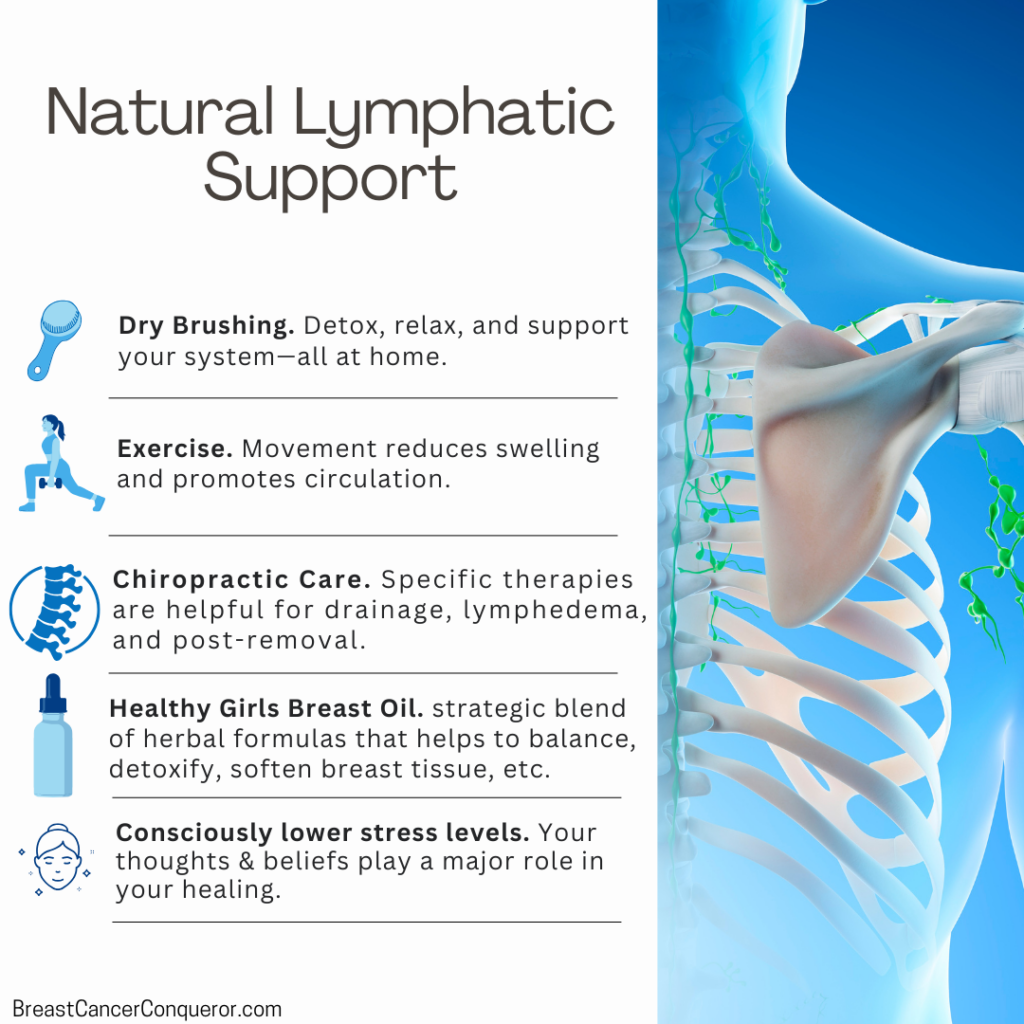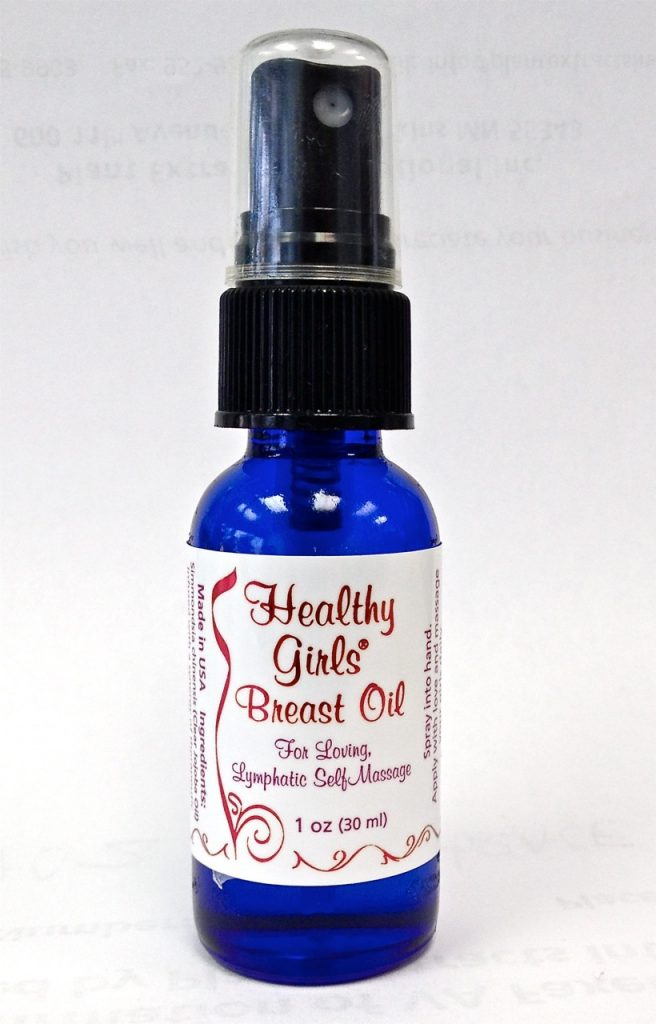
Quick read:
- Lymph nodes, especially those in the armpit (axillary nodes), are part of your immune system.
- Lymph fluid flows through a network of vessels and lymph nodes, detoxing harmful toxins from your body, as well as removing unwanted invaders like bacteria, viruses, and other pathogens.
- You can naturally improve your lymphatic health with dry brushing, exercise, chiroparatic care, manual drainage, saunas, anti-inflammation recipes, etc.
For almost 100 years, lymph node removal, particularly axillary lymph node dissection (ALND), has been a standard process. It would happen before treatment (in the form of a biopsy) or after surgery, radiation, or chemotherapy. Doctors did it in the hopes of stopping the spread of cancer cells to the sentinel lymph nodes closest to the tumor and then possibly around the body. It’s part of the outdated dogma that surgery can “get it all.”
But now that we know that breast cancer starts in your cells and healing requires a full mind, body, and soul transformation: Is this process still necessary? Even more, could removing your lymph nodes do more HARM than good?
Let’s take a look so that you can make an educated and empowered decision. If you have already had your lymph nodes removed, this blog is still an important read, as we will share how to support your lymphatic system for optimal health and healing.

The Role of Lymph Nodes in Breast Cancer
Lymph nodes, especially those in the armpit (axillary nodes), are part of your immune system. They are small, bean-shaped structures that filter lymphatic fluid and contain lymphocytes (white blood cells) that protect your body by filtering lymph fluid, identifying and destroying pathogens, and initiating immune responses. Therefore, anything designed to protect your body from diseases, infections, illnesses (and even cancer cells!) should remain IN your body.
The axillary nodes are also part of a larger network of lymph nodes throughout your body, so removing some of them will throw off your entire lymphatic system, a system that plays a crucial role in preventing and stopping the cancer.
What does my lymphatic system do?
Good question! Before we continue, let’s take a moment to truly understand your lymphatic system.
Think of it as your body’s internal cleaning crew that plays a vital role in the immune defence. Lymph fluid flows through a network of vessels and lymph nodes, detoxing harmful toxins from your body, as well as removing unwanted invaders like bacteria, viruses, and other pathogens.
But like any drainage system, it can get backed up. When too much lymph fluid accumulates or the fluid becomes thick with proteins, it can cause blockages. This condition is known as lymphedema, which can lead to painful swelling (edema) and hardening of tissue (fibrosis) if not addressed.
However, we are women of solutions, so, of course, natural ways to support healthy lymphatic systems can be found at the end of this blog!
New Research on Lymph Node Removal: It doesn’t have to be all or none.
Below are a few of the latest studies led by some of the top researchers, doctors, and medical institutions in the world. As always, we provide blogs, podcasts, and online courses to empower you to make the best decisions for your unique healing journey. There may be specific situations where removing lymph nodes is needed, so please always have thorough conversations with your medical team and always feel confident to ask for second and third opinions!
If you and your medical team are considering whether to remove many of your axillary lymph nodes or just start with a few sentinel lymph nodes, please review these recent and innovative studies.
To reduce confusion, here’s the difference between the two types of lymph nodes:
Axillary: The group of lymph nodes located in the armpit. Surgery is more extensive and usually removes ten or more nodes.
Sentinel: The first lymph node in that group that is most likely to receive cancer cells from a breast tumor. Removal is a biopsy, and it is more specific, usually just removes a few, and less intensive. Also, if the cancer has not spread to the sentinel lymph nodes it is less likely to spread throughout the body.
Research presented at the 2023 San Antonio Breast Cancer Symposium (SABCS).
This research was based on an analysis of 29 clinical trials that included, in all, a little more than 20,000 women with early breast cancer. (Study) The major findings presented included:
- “Removing lymph nodes is unnecessary for many women with early-stage breast cancer (about 65% of cases, which refers to stage 0 to 3A) who have had a lumpectomy followed by additional treatment.”
- “We’ve proven that if the sentinel node is negative (no cancer), 99 percent of the time the cancer has not spread elsewhere in the body.” Dr. Giuliano, the medical director of the Breast Oncology Program at Cedars-Sinai Cancer. He recommends: “If your doctor suggests having your axillary lymph nodes removed, you should get a second opinion.”
A 2017 study published in JAMA (Journal of the American Medical Association)
This randomized clinical trial followed 856 women for 9.3 years. (Study) The major findings included:
- The survival for patients treated with sentinel lymph node dissection alone was not inferior to that of those treated with completion axillary lymph node dissection.
- These findings do NOT support routine use of axillary lymph node dissection in this patient population based on 10-year outcomes.
A 2024 study published in the New England Journal of Medicine
This research was conducted on 2,766 patients across five countries. Half were assigned to undergo sentinel-node biopsy only, and the other half completed axillary lymph-node dissection. About 90% of all women received radiation therapy and either hormonal therapy, targeted therapy, or chemotherapy. (Study)
- Opting for a sentinel lymph node surgery (removing a few lymph nodes) versus a more extensive axillary lymph node surgery led to the same five-year recurrence-free survival rates in people with small, early-stage, clinically node-negative breast cancer with one or two positive sentinel nodes.
- About 90% of the people who had sentinel lymph node surgery and about 89% of the people who had axillary lymph node surgery were alive, with no cancer recurrence, five years after diagnosis.
As you can see, you have OPTIONS. Lymph node removal shouldn’t be just a given. Base your decisions on your body’s specific data. The BEST care is integrative. You no longer have to go “all natural” or “all conventional.” Do what will be most effective for your body, mind, and soul—so that you never have to fear breast cancer again!
Lymph Node Removal Risks
In some situations, removing lymph nodes may be necessary, especially in late-stage cases. However, there are still risks, and here are a few to note:
- Lymphedema: Swelling due to lymph fluid buildup can occur, leading to discomfort and mobility issues.
- Chronic Pain and Numbness: Nerve damage during surgery can result in chronic pain or numbness in the arm or chest.
- Limited Mobility: Scar tissue and nerve damage can restrict shoulder and arm movement.
Naturally Boost Your Lymphatic Health
No matter if you have already undergone lymph node removal or are choosing to keep your lymph nodes, here are many ways to support your lymphs and lymphatic system.
Note: As always, make sure to discuss with your medical team what supportive therapies would be best for you, depending on your unique situation.
- Healthy Girls Breast Oil. This oil is a strategic blend of herbal formulas that helps to balance, detoxify, soften breast tissue, and stimulate your immune system. It also improves lymphatic circulation while it nurtures and protects. Learn more via this podcast episode and buy the oil directly from our shop.
- Dry Brushing. “Dry brushing unclogs pores in the exfoliation process. It also helps detoxify your skin by increasing blood circulation and promoting lymph flow/drainage. By unclogging pores, it’s easier for the body to sweat and eliminate toxins in your system,” says Dr. Khetarpal of the Cleveland Clinic. From detoxing to supporting healthy lymphatic flow, dry brushing is an easy and relaxing at-home way to care for yourself. Read this blog post to learn more about it and the specific protocol we teach at the Healing Diva Retreats.
- Manual Lymphatic Drainage. A specialized massage technique to encourage lymph flow and the removal of toxins from your body. Please read this blog post to learn about lymphatic massage, dry brushing, and saunas.
- Regular Exercise. Yoga, cardio, jumping on a trampoline, lifting, and general movement can promote circulation and reduce swelling. To learn more about why we recommend HIIT classes and the benefits of exercise oncology, please read this blog post.
- Wellness Warrior Recipes. Anti-inflammatory foods support overall immune function, detoxification, and lymphatic health. Please check out our strategically designed and delicious book of recipes.
- Chiropractic Care. Chiropractic therapies, such as soft tissue therapy, can facilitate lymphatic drainage. It can be especially helpful if you are experiencing lymphedema because one or several lymph nodes were removed during conventional surgery or radiation therapy. Get more details via this blog post about chiropractic care and breast cancer healing.
- Saunas. Using an EMF-protected infrared sauna regularly prevents toxins (heavy metals, pesticides, and everything in between) from becoming “encapsulated” in your fatty tissues. Both near and far infrared saunas allow your body to sweat and promote lymphatic drainage and deep-tissue detoxification to eliminate these harmful toxins. Dive deeper via reading this blog post.
As always, you have OPTIONS.
There are plenty of things you can do in your day-to-day life that will make a big difference in your healing journey. Make critical lifestyle changes, seek out second opinions, and consider other options such as a sentinel lymph node biopsy.
Lastly, remember, every breast cancer journey is unique. Stay informed, ask questions, and choose the path that aligns best with your health and well-being.
You got this; we’ve got you.
Your next read: The Truth About Titanium Marker Clips: Are They Really Safe?


